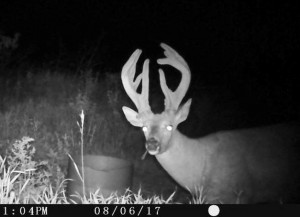 Velvet antlers have a complex system of blood vessels which causes them to be hot to the touch. Top whitetail scientist Dr. Grant Woods notes, “There is so much blood carrying protein and minerals to a buck’s antlers this time of year that even small antlers are easily detected by thermal imaging devices. Antler tines show up like neon signs when flying over with thermal cameras in summer.”
Velvet antlers have a complex system of blood vessels which causes them to be hot to the touch. Top whitetail scientist Dr. Grant Woods notes, “There is so much blood carrying protein and minerals to a buck’s antlers this time of year that even small antlers are easily detected by thermal imaging devices. Antler tines show up like neon signs when flying over with thermal cameras in summer.”
(Note: True and amazing how velvet antlers glow in a thermal imaging device. Last week on a nighttime hog hunt on a managed property in Georgia, I scanned the woods for hours with Trijicon’s IR Patrol thermal monocular and looked at a lot of good bucks; the hot-blooded antlers shined twice as white and bright than the deers’ bodies!)
Tiny hairs on the velvet stick out and make the antlers look thicker than they are. The hairs act as a radar system so a buck won’t bump into trees, fence posts, etc. and damage his soft antlers.
Sebum, a semi-liquid secretion, on those hairs gives the velvet a shiny look. Sebum also supposedly acts as an insect repellent to keep gnats, biting flies off a buck’s rack and face.
In early August antlers will begin to change from soft and pliable to hardened bone. “A buck’s antlers will change from looking swollen or bulbous at the tips of the tines to a more normal diameter,” notes Dr. Woods. “Once this change in appearance occurs the buck won’t add much beam or tine growth.”
By mid-August most of the antler growth for the year is done. Sometime between September 1 and 20 bucks will shed the velvet. The cue for antler hardening and the velvet shedding is the change in photoperiod caused by decreasing daylight and increasing darkness, which results in a significant increase in the bucks’ testosterone.






Thanks for clearing Summer Deer Antlers. Really helpfull.